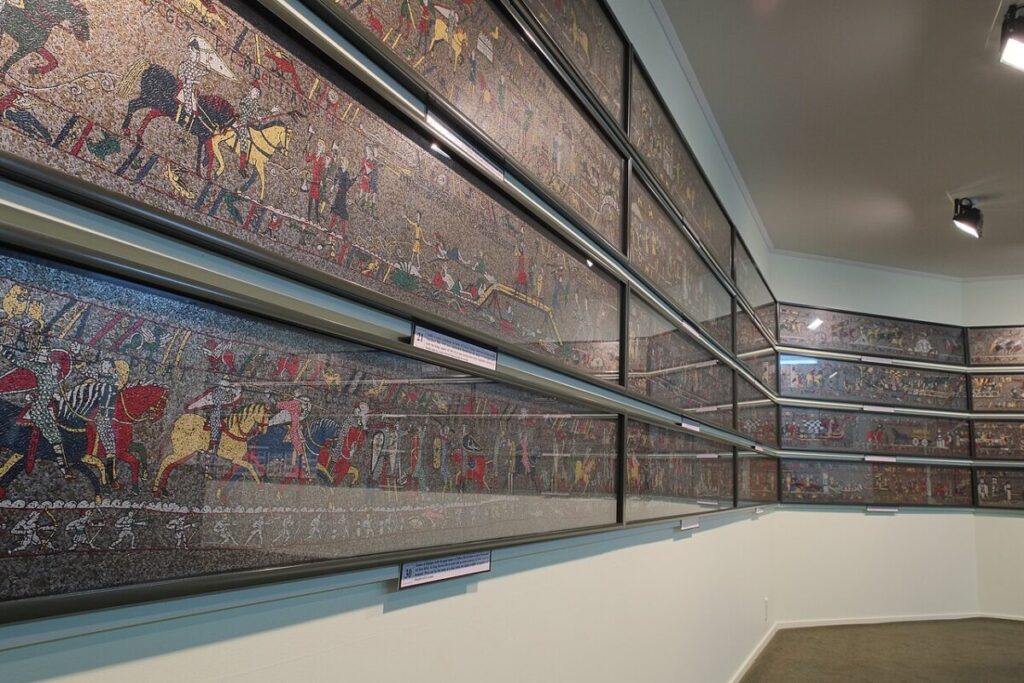The Bayeux Tapestry Moves From Normandy to London
The Bayeux Tapestry, one of Europe’s most remarkable medieval treasures, is leaving its long-time home in Normandy. Plans are underway to move it for conservation, storage, and a temporary exhibition in London.
This new move is one of the most ambitious in its history. The Bayeux Tapestry has survived Viking raids, revolutions, and world wars. Each relocation has carried risks.
The decision has sparked excitement, controversy, and concern in equal measure. Here’s a detailed look at what is happening.
What is the Bayeux Tapestry?

The Bayeux Tapestry is an embroidered linen cloth, nearly 70 meters long, created in the 11th century. It depicts the events leading to the Norman Conquest of England in 1066, culminating in the Battle of Hastings.
The work is not a true tapestry but embroidery, stitched with wool threads in colored yarns. Its survival over nine centuries makes it extraordinary, though it has endured damage, repairs, and several relocations in its history.
Since 1983, it has been housed in a purpose-built display at the Bayeux Museum in Normandy.
You can see a scrollable image of the whole tapestry here.
Why It’s Being Moved Now
The Bayeux Museum will close on 1 September 2025 for major renovation and expansion. The plan is to reopen in 2027 with a redesigned space dedicated to the tapestry.
During this closure, the tapestry cannot remain on display. French authorities have decided to store it temporarily and then loan it to the British Museum from September 2026 to July 2027.
Afterward, it will return to Normandy to be installed in the new museum.
Challenges of the Move
Moving such a fragile artifact requires years of planning. In January 2025, conservators carried out a careful cleaning inside its display case, removing dust and dismantling a fleece backing that had been sewn on in 1983.
That backing had stiffened over time, weighing down the fabric and causing strain.
In March and April 2025, the museum closed briefly to conduct extraction tests using a full-scale replica.
Conservators rehearsed how to remove the tapestry from its long display case, pack it in a custom-built crate, and move it through the building into temporary reserves.
These tests included assessing space constraints, vibration, and handling issues. Experts from the French Ministry of Culture, the Regional Directorate for Cultural Affairs, and conservation engineers are overseeing the process.
Specialized climate-controlled crates will regulate humidity and temperature during transport.
Air transport has been ruled out, as risks linked to tarmac delays and climate fluctuations were considered unacceptable. Instead, road and possibly rail transport will be used.
The Condition of the Tapestry

The tapestry is fragile. Close studies have documented thousands of stains, creases, holes, and tears.
Earlier reports, some dating to 2021–2022, advised strongly against transporting it over long distances. One study warned it should not be in transit for more than an hour.
With fibers nearly a thousand years old, any vibration or sudden movement could aggravate existing damage.
Removing the 1983 backing gave conservators a chance to inspect the cloth in detail. While necessary for long-term health, this step also left the fabric less supported.
The move will therefore require specially designed supports to prevent sagging or stress.
The Loan to the British Museum
If the move succeeds, the tapestry will go on public display at the British Museum in London from September 2026 to July 2027.
This will be the first time in centuries that the embroidery is shown in Britain, where many historians believe it was originally stitched.
The exhibition will be part of a broader cultural exchange: British artifacts such as the Sutton Hoo treasures and the Lewis Chessmen will travel to Normandy in return.
The British Museum plans a large-scale national program around the loan, involving regional partners to extend access beyond London.
For the French side, the exhibition also serves diplomatic symbolism, announced by President Emmanuel Macron during a state visit to London in July 2025.
Conservation Concerns
Not everyone agrees with the decision. Conservation specialists have raised alarms that the risks outweigh the benefits. The movement of such a fragile piece, especially over hundreds of kilometers, is seen by some as endangering its survival.
In August 2025, a petition was launched by art historian Didier Rykner, gathering tens of thousands of signatures opposing the loan.
Critics accuse the government of ignoring its own expert reports and prioritizing political symbolism over heritage preservation. They point to the secrecy around technical studies, with some reports kept confidential and little clarity on which experts endorsed the move.
The debate also reflects regional unease. For many in Normandy, the tapestry is part of local identity. The prospect of its departure, even temporarily, stirs fears of loss or irreversible damage.
The New Bayeux Museum
When the museum reopens in 2027, the tapestry will be displayed in a new purpose-built gallery within the restored Grand Séminaire building in Bayeux.
Plans call for the embroidery to be shown on a specially designed inclined table nearly 70 meters long.
This display will allow visitors to see details more clearly while keeping the textile in a safer horizontal position, rather than hung vertically as it is today.
The renovation aims not only to improve preservation but also to enhance interpretation, with updated multimedia support and renewed exhibitions on the Norman Conquest.
The project will keep Bayeux as the permanent home of the tapestry while giving it a modern framework for conservation and display.
What Remains Unknown
Security reasons mean that the transport route, storage location, and technical details of the conservation crate remain undisclosed.
Insurance arrangements and financial guarantees have not been publicly detailed either. Which expert reports were decisive in approving the move is also unclear.
Final Words
Supporters see this move as a chance to share a European masterpiece with a wider audience and to reinforce cultural ties. Opponents warn that a thousand years of history could unravel with a single mishap.
The coming months will decide whether the tapestry emerges safely from storage and travel.
